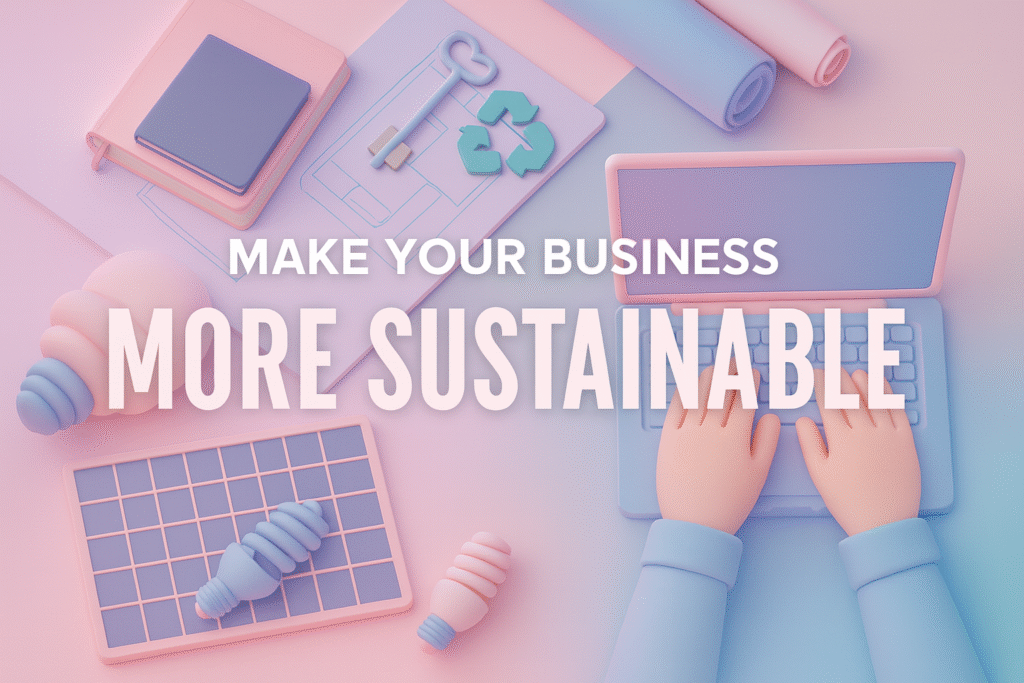Running a small business in 2025 means balancing growth with responsibility.
Customers, employees, and lenders are all looking for signs that you are cutting waste, choosing better materials, and using less energy.
Smart sustainability generally reduces costs and builds trust.
Below are seven practical moves you can make starting this quarter – no fancy jargon, just doable steps that will be profitable.
Audit What Matters And Set Three Clear Metrics
Start with facts, not assumptions. Spend a week mapping your biggest impacts: energy, such as lighting and HVAC, materials, especially packaging, and waste.
- Pull 12 months’ electricity and gas bills. Note spikes.
- List your top packaging items. Highlight anything that is oversized or heavy on the void fill.
- Compare a typical week of trash with recycling. Extend up to a month.
From that mapping, you can easily pick three metrics for the next 12 months, for instance:
- KWh per order
- Percentage of parcels right-sized
- Diversion rate (trash vs. recycling)
Treat these like mini-ESG indicators you can actually measure and share.
When you share real numbers, even something as simple as posting them on your website or in a one-page summary, you replace vague “eco-friendly” statements with transparent, measurable proof of your progress.
This kind of honest reporting is exactly what modern sustainability guides and standards encourage.
Decarbonize Your Energy Mix (in Steps You Can Afford)
You do not need rooftop solar on day one. Many small firms start by purchasing green power from their utility or through renewable energy certificates, then explore onsite solar once their cash flow supports it.
The U.S. EPA’s Guide to Purchasing Green Power breaks down options, contracts, and how to get real credit for your purchase. It is a practical primer for first-timers.
Two quick wins while you plan bigger moves:
- Program your thermostat. The DOE says adjusting setpoints ~7–10°F for 8 hours can save around 10% on heating/cooling annually, whereas ENERGY STAR cites ~8% savings with smart thermostats.
- Seal obvious leaks. Weather disabilities, seal holes around the ducts, and keep filters clean. These are low-priced functions with immediate comfort and cost benefits.
Use Digital Tools And Sensors to Find Hidden Waste
Small businesses are increasingly dependent on IoT (sensors, smart plugs, energy plaster) to trace real-time waste, so much so that some are calling it a sustainability trend. Think of a light on after a power failure, or a refrigerator that breaks down.
The company’s expenses on IoT are increasing, reflecting the widespread adoption of these units to more intelligently manage energy and maintenance.
Even a basic setup (smart meter + coating sensor) can provide fast, visible savings.
A simple starter stack:
- Smart plugs for displays and point-of-sale peripherals you can schedule off.
- Occupancy sensors in storerooms and restrooms.
- A cloud meter or utility portal alert for unusual spikes (catch that stuck heater or faulty chiller fast).
Fix Packaging With Right-Sizing And Honest End-of-Life
Packaging is your customer’s first tactile signal that you care. Go for right-sized, high-recycled, curbside-recyclable options and keep the disposal instructions clear on the flap or insert.
The latest paper industry data shows 69%–74% of cardboard available for recovery in the U.S. was actually recycled in 2024, so choosing fiber-based formats gives customers an end-of-life pathway they can access at home.
What to change first:
- Right-size boxes to cut material, void fill, damage, and dimensional-weight fees.
- Specify recycled content by percentage (especially post-consumer) and say “Curbside recyclable” when true.
- Be cautious with “biodegradable/compostable” claims unless your customers have access to industrial composting. The FTC’s Green Guides warn against broad claims that can mislead; stick to specific, verifiable statements.
If you ship DTC and want branded, recyclable packaging designed to fit your product, custom kraft boxes are a practical option many retailers adopt.
The customization helps reduce shipping air, and kraft (with high recycled content) aligns with curbside recycling in most communities, supporting both sustainability and cost control.
Clean up The Last Mile And Make Returns Smarter
Shipping emissions add up, but you can shrink them without hurting customer experience:
- Offer an “eco-ship” option at checkout (consolidated or slower shipping) and explain why it helps. Many shoppers will choose it when the benefit is clear.
- Batch returns to a weekly pickup or use drop-off networks so carriers consolidate miles.
- Cut air in parcels (ties back to right-sizing) to lower fuel and fees.
- Keep packaging fiber-based where possible; paper/cardboard recovery is widely available compared to many mixed plastics, making it easier for customers to do the right thing.
A practical touch: add a small insert titled “How to recycle or reuse this packaging” plus a QR code to a 30-second page or short video.
Build a Supplier Scorecard That Fits on One Page
Your footprint extends upstream. Create a simple scorecard and grade vendors A/B/C on four things:
- Material transparency: Do they publish recycled content by percentage (especially post-consumer)?
- End-of-Life Clarity: Curbside Recyclable vs. Industrial Compost Only, be precise.
- Certification: For example, FSC for paper, Credible Energy/Water certification for facilities.
- Ability to right-size: Can they create dimensions to cut down on waste and freight?
Revisit the scorecard twice a year and share the “why” with customers: “We switched to 100% recycled corrugated and reduced box size by 18%.” Specific, verifiable claims engage you with the Green Guide and build trust.
Turn Customers And Staff Into Co-Creators of Sustainability
Sustainability sticks when it is social.
- Inside your team: Run a quarterly “Green 10” challenge, each employee pitches one idea to save energy, time, or material. Fund the winner and post results (“What we changed, what we saved”) in break rooms or Slack.
- With customers: Nudge reuse where it is easy. Coffee chains showed this can work at scale: since January 2024, Starbucks has allowed personal reusable cups even in drive-thru and mobile orders across the U.S. and Canada. This proves that reuse can be convenient when you design for it. Consider a small discount for bring-back containers in your own shop.
Wrapping Up
Sustainability does not require a large budget or thorough planning.
It rewards clarity and sustainability: Objectives, A few important things, upgrading the obvious (LEDs, smart thermostats, the right size recycled packaging), cleaning up shipping and returning, and getting your suppliers, employees, and customers on board.
Divide hard numbers, follow green guidelines, and promote practical reuse.
Start a little, measure honestly, and improve month after month.
In this way, a small company becomes more sustainable in 2025, reducing costs, pleasing customers, and building a brand people are proud to choose.









